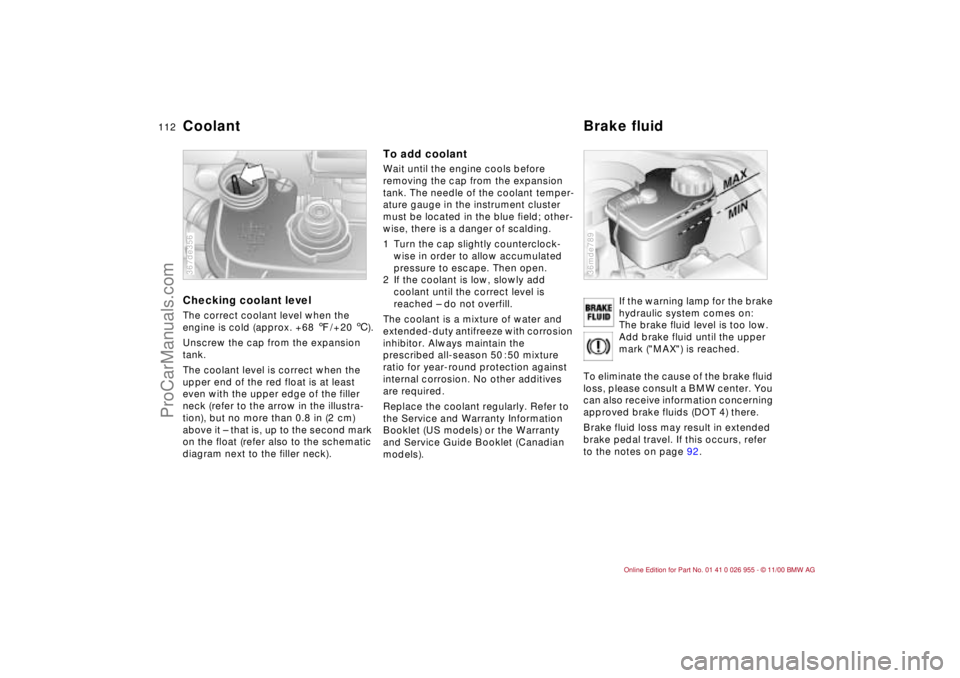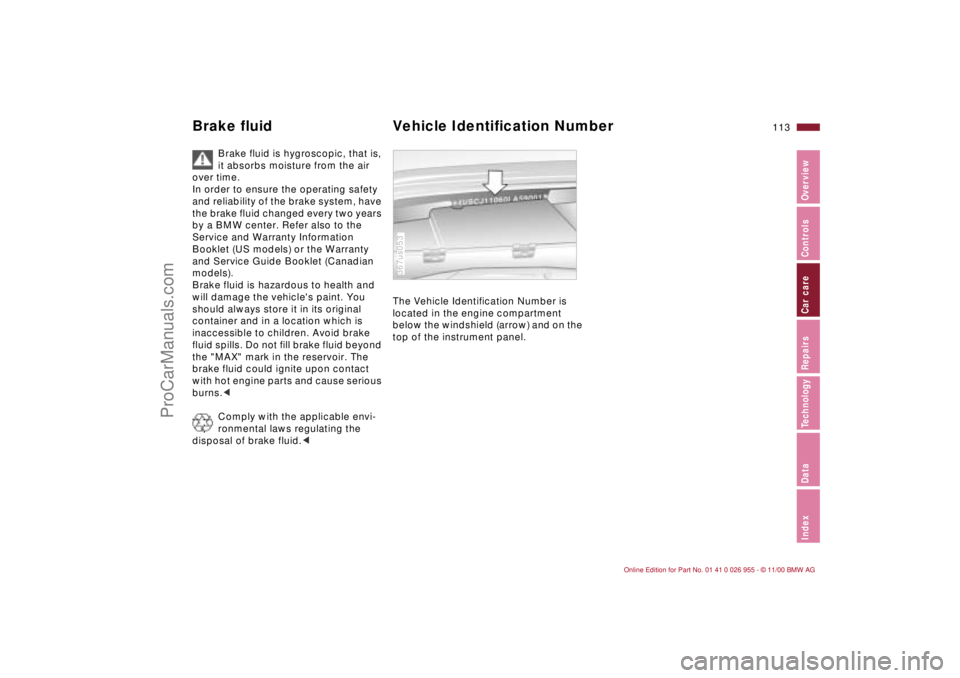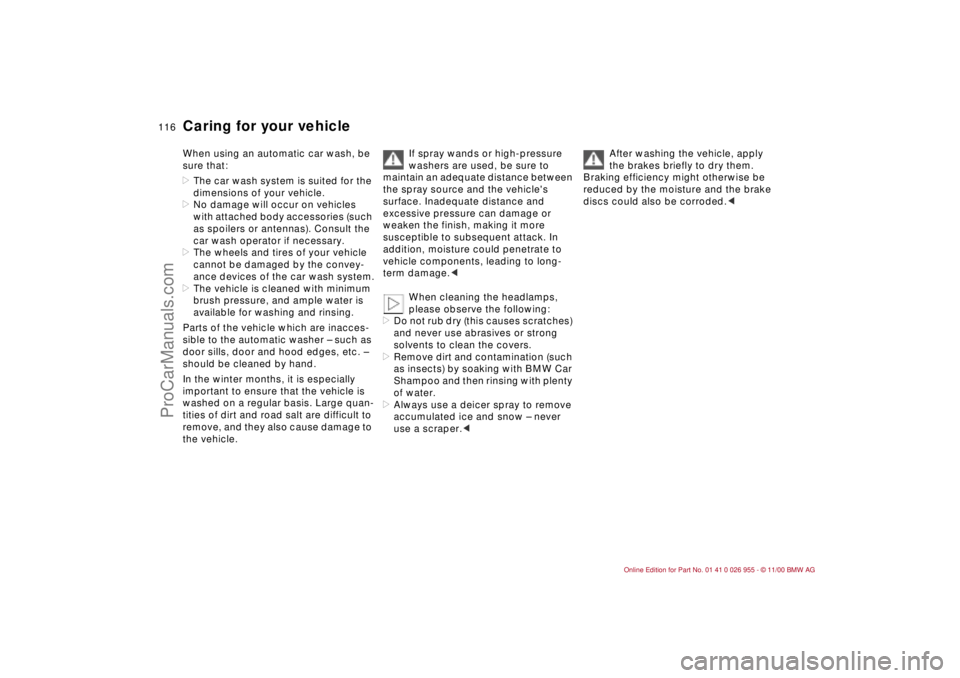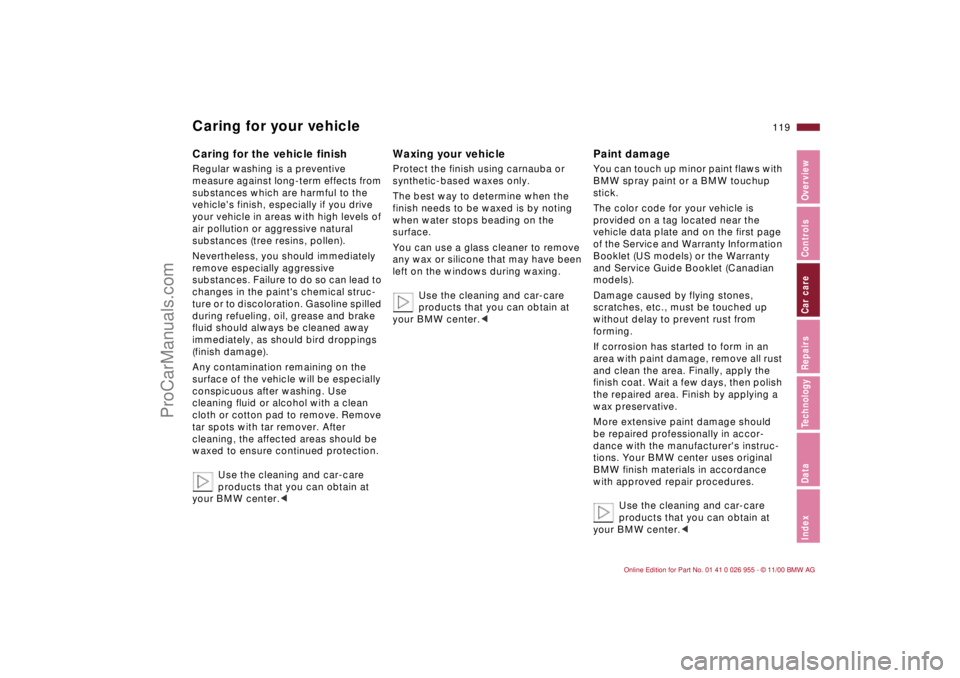2001 BMW M ROADSTER COUPE brake
[x] Cancel search: brakePage 93 of 171

93n
IndexDataTechnologyRepairsCar careControlsOverview
Winter operationThe onset of winter is often accompa-
nied by rapid changes in weather.
Adaptations in driving style should be
accompanied by preparations on the
vehicle itself to ensure that your vehicle
operation through the winter remains
safe and trouble-free.CoolantEnsure that the coolant contains the
year-round 50 : 50 ratio of water and
antifreeze with corrosion inhibitor.
This mixture provides protection
against freezing down to approx.
– 34 7 (– 37 6). Replace the coolant
every three years.LocksBMW door lock deicer can be used to
free the doors if they are frozen. This
deicer also contains lubricant.
After using deicer, treatment with BMW
lock cylinder grease is recommended.
Rubber seals and components In order to prevent freezing, apply BMW
rubber treatment or silicone spray to
weather-stripping on the doors, hood,
luggage compartment and to convert-
ible top seals.
A full range of car-care products is
available from your BMW center.< Snow chainsMount the BMW snow chains
* only in
pairs on the rear wheels only. Comply
with the manufacturer's safety precau-
tions. Do not exceed a speed limit of
30 mph (50 km/h) when driving with
chains. As an exception in this situa-
tion, we recommend that you deacti-
vate the DSC and RDW when snow
chains are mounted. Refer to page 65
or page 67.
Starting offWhen starting from a full stop or
"rocking" free in deep snow, we recom-
mend that you deactivate the DSC
system. Refer to page 65.Driving on low-traction road
surfacesUse smooth, gentle pressure to control
the accelerator pedal. Avoid excessive
engine speeds and shift to the next
higher gear at an early point. Shift down
into the next lowest gear when
approaching uphill or downhill grades.
Maintain an adequate distance between
yourself and the vehicle ahead.Braking Winter road conditions substantially
reduce the traction available between
the tires and the road surface.
Remember that – in every situation –
braking distances will be significantly
longer as a result of this.
ABS is intended to prevent the wheels
from locking during brake applications,
thus helping to maintain vehicle stability
and steering response.
ProCarManuals.com
Page 94 of 171

94n
Winter operation Power steeringIf it should occur that the ABS does not
respond in a critical braking situation
and the wheels lock: reduce the pres-
sure on the brake pedal until the wheels
just start to roll again while still main-
taining enough force to continue
braking. Following that, increase pedal
pressure again. Reduce the pressure as
the wheels lock, then reapply pressure.
Repeat this process.
This type of staggered braking will
lower the braking distance, and the
vehicle still remains responsive to
steering.
You can still attempt to steer around
hazards once you have reduced the
pressure on the brake pedal.
Do not shift down on slick road
surfaces. Doing so could cause
the rear wheels to lose traction and
skid, which could result in the loss of
vehicle control.<
Depress the clutch pedal during
hard braking on road surfaces
which provide only poor or uneven trac-
tion.<
Skid controlDepress the clutch pedal and release
the accelerator pedal. Countersteer
carefully and attempt to regain control
of the vehicle.ParkingEngage 1st or reverse gear. Depending
on the steepness of the incline, you can
apply the parking brake as well. In order
to prevent the parking brake pads from
locking due to frost or corrosion, dry
them by gently applying the parking
brake as the vehicle is coming to a stop.
Make sure that following traffic is not
endangered.
The brake lamps do not light
up when the parking brake is
applied.<
Changes in steering response
(high steering effort, for example):
Consult a BMW center to have the
system checked.
If the power steering fails,
increased effort will be required
to steer the vehicle.<
ProCarManuals.com
Page 103 of 171

103n
IndexDataTechnologyRepairsCar careControlsOverview
Approved wheel and tire specifications
Have winter tires mounted at your
BMW center or a tire dealer.<
Snow chains
*
Deactivate the Tire Pressure
Warning (RDW) when using snow
chains. The snow chains can lead to
malfunction warnings and undetected
losses in pressure.
For further information, refer to
page 67.< BMW tests certain tire brands for each tire size, classifies them as road-safe and
approves them. Consult your BMW center for more information.
Observe any regulations applicable in the country of use, e.g. requiring entry in the
vehicle documents.
Tire specifications Suitable for
snow chainsLight-alloy wheel
M roadster, M coupe
Summer
Front: 225/45 ZR 17
Rear: 245/40 ZR 17–
–7.5Jx17 AH 2 IS 41
9Jx17 AH 2 IS 8
Winter (M+S)
225/45 R 17 90 H[Front: 7.5Jx17 EH 2 IS 41
Rear: 7.5Jx17 EH 2 IS 25
Wheel with asymmetrical hump
(AH)The rim design with a so-called asym-
metrical hump results in a clearly
extended holding of the tire on the rim
in the case of a leak compared to the
usual symmetrical hump, so that the
vehicle can be braked to a stop more
safely. Another advantage of the asym-
metrical hump is that no special tire is
required.
ProCarManuals.com
Page 107 of 171

107n
IndexDataTechnologyRepairsCar careControlsOverview
Engine compartment1 Brake fluid reservoir112
2 Fuse box142
3 Coolant expansion tank112
4 Engine oil dipstick109
5 Engine oil filler neck109
6 Reservoir for windshield and
headlamp
* washer system108
7 Auxiliary terminal for jump-starting –
negative terminal144
8 Auxiliary terminal for jump-starting –
positive terminal144
ProCarManuals.com
Page 112 of 171

112n
Coolant Brake fluid Checking coolant levelThe correct coolant level when the
engine is cold (approx. +68 7/+20 6).
Unscrew the cap from the expansion
tank.
The coolant level is correct when the
upper end of the red float is at least
even with the upper edge of the filler
neck (refer to the arrow in the illustra-
tion), but no more than 0.8 in (2 cm)
above it – that is, up to the second mark
on the float (refer also to the schematic
diagram next to the filler neck).367de356
To add coolantWait until the engine cools before
removing the cap from the expansion
tank. The needle of the coolant temper-
ature gauge in the instrument cluster
must be located in the blue field; other-
wise, there is a danger of scalding.
1 Turn the cap slightly counterclock-
wise in order to allow accumulated
pressure to escape. Then open.
2 If the coolant is low, slowly add
coolant until the correct level is
reached – do not overfill.
The coolant is a mixture of water and
extended-duty antifreeze with corrosion
inhibitor. Always maintain the
prescribed all-season 50 : 50 mixture
ratio for year-round protection against
internal corrosion. No other additives
are required.
Replace the coolant regularly. Refer to
the Service and Warranty Information
Booklet (US models) or the Warranty
and Service Guide Booklet (Canadian
models).If the warning lamp for the brake
hydraulic system comes on:
The brake fluid level is too low.
Add brake fluid until the upper
mark ("MAX") is reached.
To eliminate the cause of the brake fluid
loss, please consult a BMW center. You
can also receive information concerning
approved brake fluids (DOT 4) there.
Brake fluid loss may result in extended
brake pedal travel. If this occurs, refer
to the notes on page 92.
36mde789
ProCarManuals.com
Page 113 of 171

113n
IndexDataTechnologyRepairsCar careControlsOverview
Brake fluid Vehicle Identification Number
Brake fluid is hygroscopic, that is,
it absorbs moisture from the air
over time.
In order to ensure the operating safety
and reliability of the brake system, have
the brake fluid changed every two years
by a BMW center. Refer also to the
Service and Warranty Information
Booklet (US models) or the Warranty
and Service Guide Booklet (Canadian
models).
Brake fluid is hazardous to health and
will damage the vehicle's paint. You
should always store it in its original
container and in a location which is
inaccessible to children. Avoid brake
fluid spills. Do not fill brake fluid beyond
the "MAX" mark in the reservoir. The
brake fluid could ignite upon contact
with hot engine parts and cause serious
burns.<
Comply with the applicable envi-
ronmental laws regulating the
disposal of brake fluid.<
The Vehicle Identification Number is
located in the engine compartment
below the windshield (arrow) and on the
top of the instrument panel. 367us053
ProCarManuals.com
Page 116 of 171

116n
Caring for your vehicleWhen using an automatic car wash, be
sure that:
>The car wash system is suited for the
dimensions of your vehicle.
>No damage will occur on vehicles
with attached body accessories (such
as spoilers or antennas). Consult the
car wash operator if necessary.
>The wheels and tires of your vehicle
cannot be damaged by the convey-
ance devices of the car wash system.
>The vehicle is cleaned with minimum
brush pressure, and ample water is
available for washing and rinsing.
Parts of the vehicle which are inacces-
sible to the automatic washer – such as
door sills, door and hood edges, etc. –
should be cleaned by hand.
In the winter months, it is especially
important to ensure that the vehicle is
washed on a regular basis. Large quan-
tities of dirt and road salt are difficult to
remove, and they also cause damage to
the vehicle.If spray wands or high-pressure
washers are used, be sure to
maintain an adequate distance between
the spray source and the vehicle's
surface. Inadequate distance and
excessive pressure can damage or
weaken the finish, making it more
susceptible to subsequent attack. In
addition, moisture could penetrate to
vehicle components, leading to long-
term damage.<
When cleaning the headlamps,
please observe the following:
>Do not rub dry (this causes scratches)
and never use abrasives or strong
solvents to clean the covers.
>Remove dirt and contamination (such
as insects) by soaking with BMW Car
Shampoo and then rinsing with plenty
of water.
>Always use a deicer spray to remove
accumulated ice and snow – never
use a scraper.<
After washing the vehicle, apply
the brakes briefly to dry them.
Braking efficiency might otherwise be
reduced by the moisture and the brake
discs could also be corroded.<
ProCarManuals.com
Page 119 of 171

119n
IndexDataTechnologyRepairsCar careControlsOverview
Caring for your vehicleCaring for the vehicle finishRegular washing is a preventive
measure against long-term effects from
substances which are harmful to the
vehicle's finish, especially if you drive
your vehicle in areas with high levels of
air pollution or aggressive natural
substances (tree resins, pollen).
Nevertheless, you should immediately
remove especially aggressive
substances. Failure to do so can lead to
changes in the paint's chemical struc-
ture or to discoloration. Gasoline spilled
during refueling, oil, grease and brake
fluid should always be cleaned away
immediately, as should bird droppings
(finish damage).
Any contamination remaining on the
surface of the vehicle will be especially
conspicuous after washing. Use
cleaning fluid or alcohol with a clean
cloth or cotton pad to remove. Remove
tar spots with tar remover. After
cleaning, the affected areas should be
waxed to ensure continued protection.
Use the cleaning and car-care
products that you can obtain at
your BMW center.<
Waxing your vehicleProtect the finish using carnauba or
synthetic-based waxes only.
The best way to determine when the
finish needs to be waxed is by noting
when water stops beading on the
surface.
You can use a glass cleaner to remove
any wax or silicone that may have been
left on the windows during waxing.
Use the cleaning and car-care
products that you can obtain at
your BMW center.<
Paint damageYou can touch up minor paint flaws with
BMW spray paint or a BMW touchup
stick.
The color code for your vehicle is
provided on a tag located near the
vehicle data plate and on the first page
of the Service and Warranty Information
Booklet (US models) or the Warranty
and Service Guide Booklet (Canadian
models).
Damage caused by flying stones,
scratches, etc., must be touched up
without delay to prevent rust from
forming.
If corrosion has started to form in an
area with paint damage, remove all rust
and clean the area. Finally, apply the
finish coat. Wait a few days, then polish
the repaired area. Finish by applying a
wax preservative.
More extensive paint damage should
be repaired professionally in accor-
dance with the manufacturer's instruc-
tions. Your BMW center uses original
BMW finish materials in accordance
with approved repair procedures.
Use the cleaning and car-care
products that you can obtain at
your BMW center.<
ProCarManuals.com